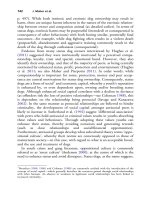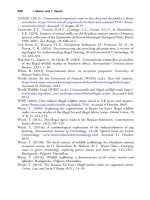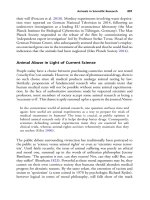The palgrave international handbook of a 102
Bạn đang xem bản rút gọn của tài liệu. Xem và tải ngay bản đầy đủ của tài liệu tại đây (28.34 KB, 1 trang )
92
A. Nurse
animals that ‘have overwhelmed that person’s ability to provide even minimal standards of nutrition, sanitation and veterinary care’ (2010, p. 10).
Although such neglect is sometimes driven by good intentions, for example,
a desire to help and protect non-human animals, it nonetheless represents
abuse where animals are kept in poor conditions which give rise to animal
welfare and environmental health offences. However hoarding also represents a dysfunctional human–animal relationship where individuals may
actively ‘collect’ animals as companions (see also the chapter on Collecting
of Wildlife). Patronek and Nathanson (2009, p. 274) explained that animal
hoarding is maladaptive, destructive behaviour where ‘compulsive caregiving of animals can become the primary means of maintaining or building a
sense of ‘self’’.
Neglect Legislation and Enforcement
At the heart of arguments supporting non-human animal welfare as a precursor
to animal rights is the perception that society increasingly considers animal
welfare to be important and that animals, as sentient beings adversely affected
by human behaviour, require legal protection that can best be achieved by
providing animals with legal rights (Regan 1983; Wise 2000). As this chapter
indicates, animal welfare legislation primarily aims to protect animals from
abuse whether intentional or unintentional (Nurse 2013), although ‘animal
welfare’ and ‘animal abuse’ are often interchangeable terms in policy debates.
Schaffner (2011) distinguishes between anti-cruelty and animal welfare laws
noting that different types of law reflect different policy intentions. Anticruelty laws are usually negative, specifying prohibited acts, whereas animal
welfare laws are generally positive, specifying required standards. However
both types of law arguably define the precise nature of unlawful abuse and
contextualise prohibited activity within legislative and public policy objectives
which underpin legislative priorities. Thus, within anti-cruelty statutes ‘laws
protect animals from the intentional and gratuitous infliction of pain and
suffering at the hands of humans’ (Schaffner 2011, p. 22). Whereas animal
welfare laws generally regulate humans use of animals and ‘set standards
beyond the mere prohibition of cruel practices already outlawed by the anticruelty laws’ (Schaffner 2011, p. 70), notwithstanding the reality that exemptions generally exist allowing continued animal use for food or research
purposes (subject to restrictions). While Ibrahim’s (2006) notion of a welfarist
approach and humane treatment for animals is primarily aimed at preventing
or reducing suffering, animal welfare laws have increasingly sought to recognise









